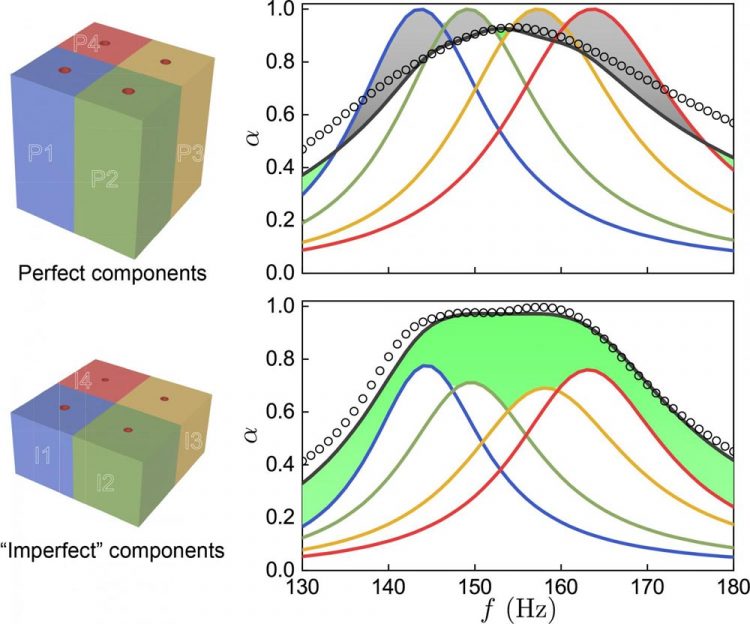Compact broadband acoustic absorber with coherently coupled weak resonances

Schematic (left) and absorption comparison (right) of hybrid metasurfaces consisting of perfect and imperfect components; Credit: ©Science China Press
The recent advance in acoustic metamaterial/metasurface brings forward perfect absorbers (resonators) that possess ultra-thin thickness but relatively narrow working frequency bandwidth.
Then these perfect resonators with quasi-perfect absorption are combined to piece together a broad absorbing band. However, the requirement of quasi-perfect absorption substantially places a very strict restriction on the impedance and thickness of the resonators.
Recently, the research teams from Tongji University and The Hong Kong Polytechnic University go a counter-intuitive way — coupling imperfect components that possess low absorption peaks to achieve a compact broadband acoustic absorber.
Their work opens a new pathway for this challenging goal by exerting the coherent coupling effect among the imperfect components to an unprecedentedly dominant role. This lifts the major restrictions on each component and frees the manipulation of coherent coupling effect.
Results show that although each of the components exhibits rather low absorption peak individually, by suitably modulating the coherent coupling effect among the imperfect components, they work collectively to provide a broadband (870 – 3224 Hz) quasi-perfect absorption (average coefficient reaches 0.957).
This work explores compact broadband acoustic absorbers with coherently coupled weak resonances and provides deep insight into the fundamental characteristics of these coupling systems, which may pave the way for developing novel acoustic devices against low frequency noise, and pave a way to modulate the surface acoustic impedance arbitrarily in broadband.
###
See the article: Sibo Huang, Zhiling Zhou, Dongting Li, Tuo Liu, Xu Wang, Jie Zhu, Yong Li. Compact broadband acoustic sink with coherently coupled weak resonances. Science Bulletin, doi: 10.1016/j.scib.2019.11.008
https:/
Media Contact
Yong Li
yongli@tongji.edu.cn
Media Contact
More Information:
http://dx.doi.org/10.1016/j.scib.2019.11.008All latest news from the category: Physics and Astronomy
This area deals with the fundamental laws and building blocks of nature and how they interact, the properties and the behavior of matter, and research into space and time and their structures.
innovations-report provides in-depth reports and articles on subjects such as astrophysics, laser technologies, nuclear, quantum, particle and solid-state physics, nanotechnologies, planetary research and findings (Mars, Venus) and developments related to the Hubble Telescope.
Newest articles

Properties of new materials for microchips
… can now be measured well. Reseachers of Delft University of Technology demonstrated measuring performance properties of ultrathin silicon membranes. Making ever smaller and more powerful chips requires new ultrathin…

Floating solar’s potential
… to support sustainable development by addressing climate, water, and energy goals holistically. A new study published this week in Nature Energy raises the potential for floating solar photovoltaics (FPV)…

Skyrmions move at record speeds
… a step towards the computing of the future. An international research team led by scientists from the CNRS1 has discovered that the magnetic nanobubbles2 known as skyrmions can be…





















